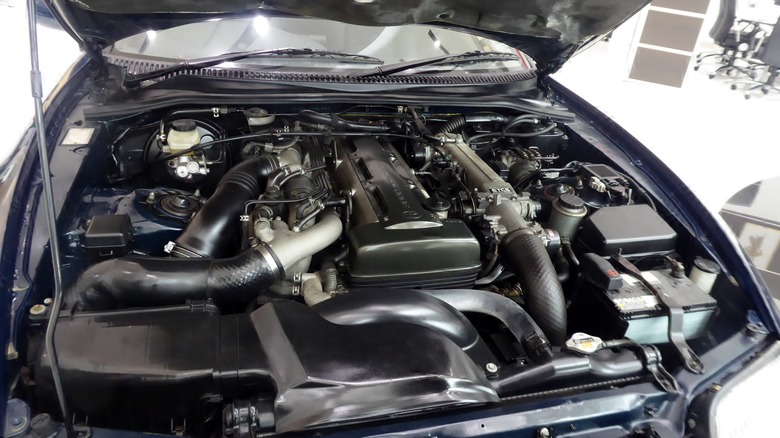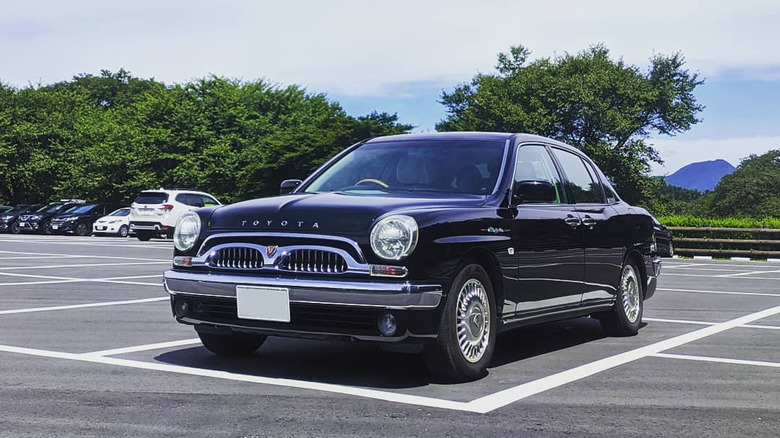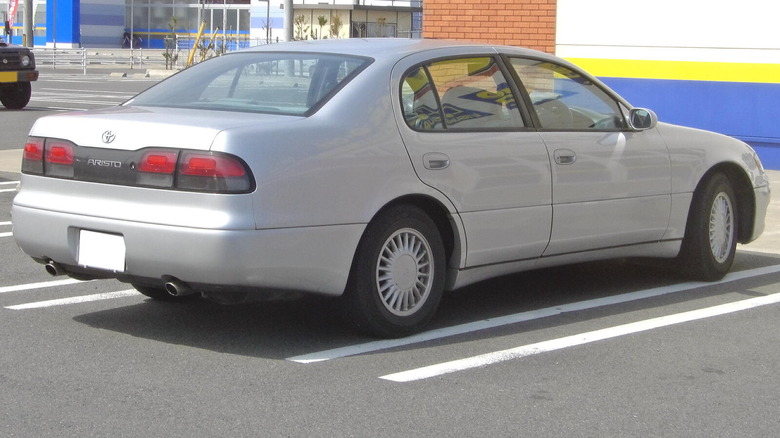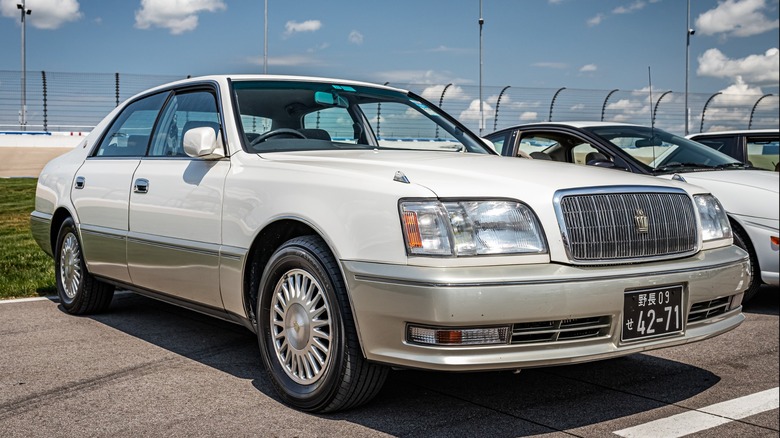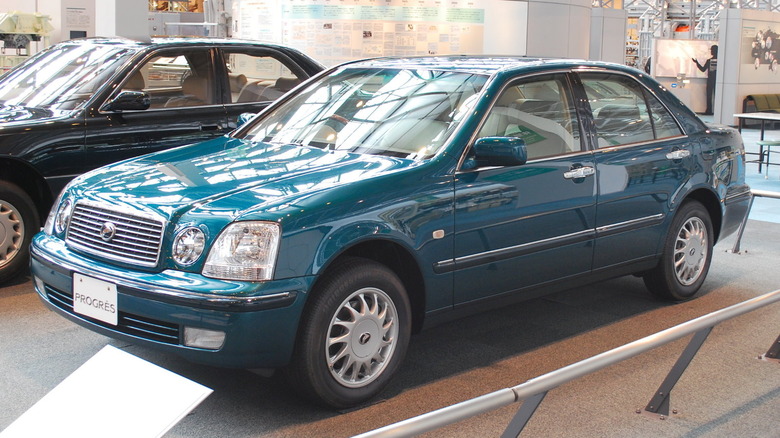4 Toyota Models Powered By The Legendary 2JZ Engine
Asking an automotive enthusiast to name an iconic engine is a sure-fire way to get someone to say "2JZ." For good reason, too. The 2JZ, as many people know, was the powerplant for the legendary fourth-generation (A80/MK4) Toyota Supra. It's a vehicle that's deep-rooted in car culture to the point that it has, in itself, become a pop culture icon. It's a movie star, subject to more automotive YouTube videos than one could possibly count, and has worked its way from nearly every motorsports discipline, spanning the likes of drift events to drag strips.
Though the Supra is the first car most folks will think of when prompted to come up with a vehicle powered by a 2JZ, the engine found its way into a myriad of Toyota chassis that some folks may be entirely unaware of. Many know that the 2JZ was also the powerplant for Lexus models like the GS300, IS300, and SC300. However, strictly sticking to vehicles with a Toyota badge, there are still quite a few 2JZ-powered models. Here are four excellent examples!
Toyota Origin
Let's come out swinging with one of the most unique and unknown Toyota models to feature the 2JZ: The Toyota Origin. Based on its styling, you might think that the Origin predates the 2JZ. You'd be wrong, but there is a historical reason for its retro design cues.
Toyota released the Origin in 2000 and only made around 1,000 examples. Its 212 horsepower comes courtesy of a naturally aspirated Toyota 2JZ-GE engine. Toyota says the Origin's styling is based on the first-generation Crown. It was built to commemorate the production of its 100-millionth domestic vehicle.
Don't expect to spot a Toyota Origin cruising around town any time soon. Its original sale price works out to just shy of $50,000 today. That, combined with the fact that Toyota only produced around 1,000 of them and they were sold exclusively in Japan, means it's quite a rare sight indeed. If you're in the U.S. and you start saving now, maybe you can hunt one down and buy one when it becomes legal for import in the year 2035.
Toyota Aristo
We'd be remiss not to include the first-generation Toyota Aristo in this list because it's the only car other than the A80 Toyota Supra that used the turbocharged version of the straight-six icon: the 2JZ-GTE. As you may have deciphered from context, the "T" added to the name indicates that it's turbocharged. In addition, the first-gen Aristo was designed by the same company that penned the BMW M1, the DeLorean DMC-12, and the original Volkswagen Golf: Italdesign.
Toyota created the Aristo as a high-performance sedan with modern tech and amenities. Its use of a torque-sensing limited-slip differential and substantial "276 horsepower" power output put its performance and prowess in a similar category to performance sedans from BMW and Mercedes. For those unaware, the power output is in quotation marks because Japanese manufacturers came to a so-called "Gentleman's Agreement" to limit production cars to 276 horsepower for many years. In some cases, notably the Nissan Skyline GT-R, the delivered versions of some cars with "276" horsepower actually came with a fair bit more than that.
Toyota produced the first-gen Aristo from 1991 to 1996. For the 1997 model year, Toyota introduced the second-generation Aristo, which also offered the 2JZ-GTE with, you guessed it, "276 horsepower." Both generations also had naturally aspirated lower-trim models with the 2JZ-GE.
Toyota Crown
We'd be just as remiss not to bring the longest-running nameplate in Toyota's history. Born over 70 years ago, the Toyota Crown is still in production today. However, if we split that seventy years nearly perfectly in half and venture back to 1991, we land in the birth year of the ninth-generation Toyota Crown.
The highest trim level of the Toyota Crown sedan, the "Royal Saloon G," had none other than the iconic Toyota 2JZ-GE under the hood. Interestingly, stepping down to the standard "Royal Saloon" trim netted a 1JZ engine, which is nearly as iconic as the 2JZ. Though neither of them was the sought-after turbocharged version, it is pretty cool that you could pick from either one in the same model. Of course, there's no way buyers in 1991 could have known how iconic the engines would go on to become.
In 2001, Toyota released the tenth generation of the Toyota Crown, which also came with both 1JZ and 2JZ power. However, these two generations were the only models of the extensive Toyota Crown lineup to feature the legendary 2JZ engine.
Toyota Progrès
We're going to finish the way we started: a lesser-known and somewhat goofy slice of Toyota history known as the Toyota Progrès. That's French for "Progress." You probably figured that out.
The Toyota Progrès was produced from 1998 until 2007 and shared platforms with the second-gen Toyota Aristo (or Lexus GS300 as delivered to the U.S.) and the tenth-generation Toyota Crown. Considering both of those models also appeared on this list, it makes sense that the Progrès would also share powerplants with them. Like the Crown, the Progrès came with both the 1JZ and 2JZ, depending on trim levels. NC300 models came with the 2JZ engine, while the NC250 trim level came with the 1JZ. The cream of the crop was the NC300 "Walnut Package," which included a plush leather interior and upgraded sound system. As the name would apply, it also featured woodgrain panels made from Walnut.
The Toyota Progrès progressed in production until the 2007 model year when Toyota discontinued it. 2007 also marked the final production year of the 2JZ engine. So, the Progrès was one of the very last production cars to get a 2JZ from the factory. Though, based on its alive-and-well popularity in tuning culture, you'd think it's still in production to this day.
